Short version, here is the finished product- a drum within a drum wood burning water heater for heating the inside of my house- it is ugly but functional:
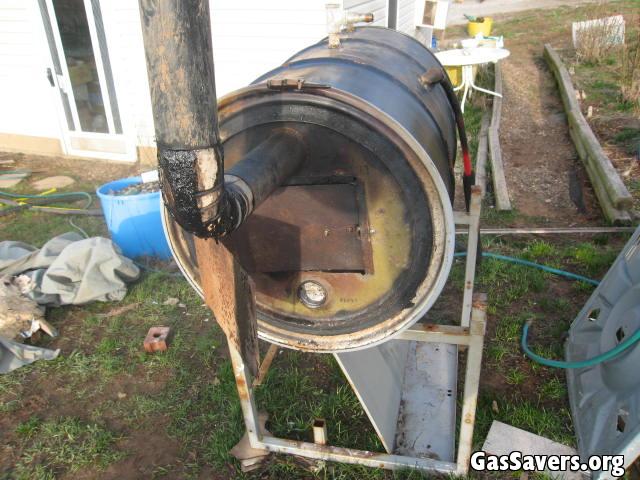
If you want to know the whole, long story, keep reading.
A friend had a huge walnut tree blow down 2 years ago so I cut most of it up into firewood sized chunks and hauled it to my house (I sawed the big logs into furniture lumber with my home made band saw mill but that is another story). My wife and I already have a geothermal heat pump (closed loop) but we are real cheapskates and love saving money so I decided to come up with a way to get the free energy of the firewood into the house without installing an indoor wood stove.
Here was my first prototype (yes- it is very rough and very ugly). It is an old wood burning stove with a gas water heater mounted on top.
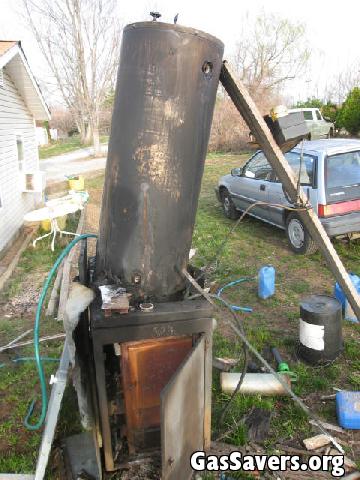
My in laws were remodeling and replaced their aging natural gas water heater with a newer model. The tank was still good and I had an old wood burning stove laying around so I decided to cut a round hole in the top of the wood stove to match the base of the gas water heater. As most people know, gas water heaters have the flue through the center, so I figured that would work well to capture heat from the fire underneath. It worked OK- but it really took a lot of wood to heat up the water to a usable temp 85 degree water in the house (most of the heat was escaping from the sides of the stove). We set our heat pump thermostat on 63 and then just tried to keep the heat pump off by running this wood burner.
I opened up the ash door so it would burn wide open and get the water hotter (100 degrees was a hot day for this stove). The wall of the stove began to sag from the intense heat and the weight of 40 gallons of water sitting on top of it. I had to use a board to keep it from falling over. By the way, that small black tank on the right at eye level is my experimental waste oil burning set up, when the fire got really hot, I slowly dripped in oil through a copper pipe and it burned without any noticeable smoke.
How did I get the heat into the house?
Answer, with 3/4 PEX pipe, a Taco pump (sits on the back porch under a waterproof cover which is not shown), an aluminum automotive radiator and a box fan. I ran the pipes through a window and foamed around them to minimize drafts.
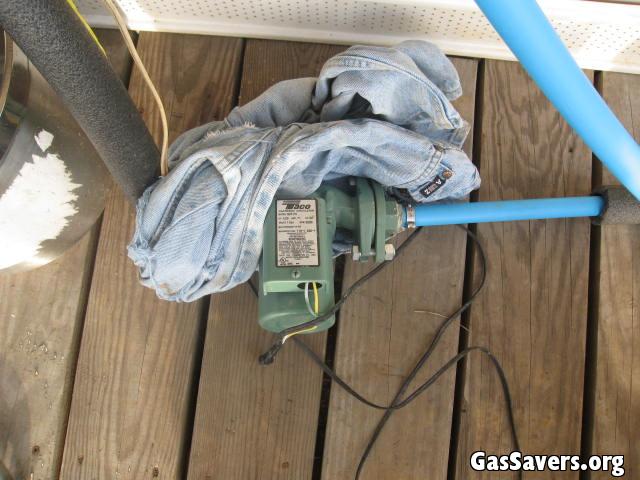
Pump is insulated with an old pair of blue jeans
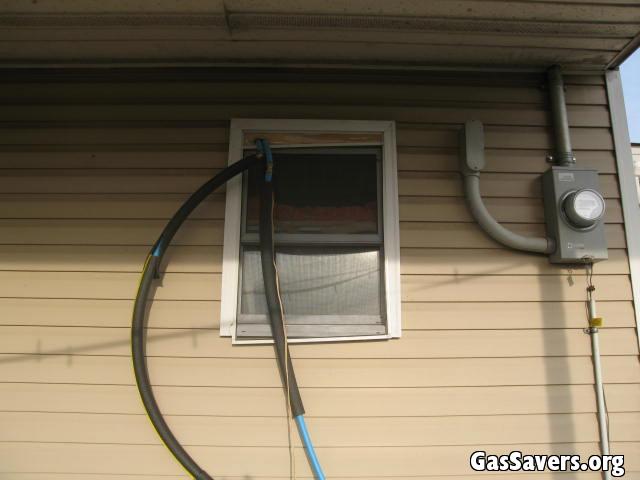
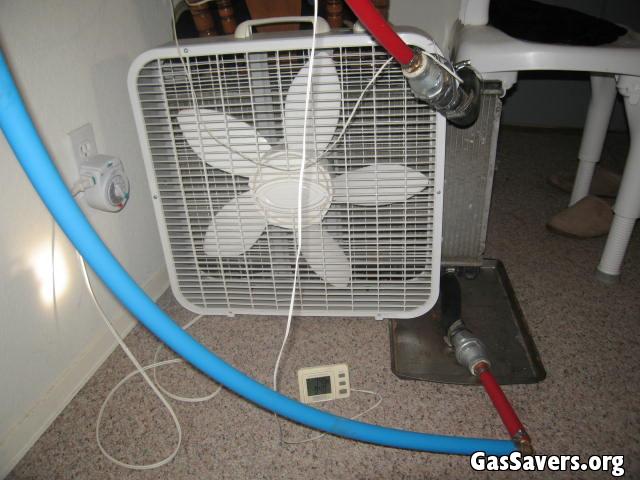
Current temp on thermometer= 94 degrees= about average for a decent fire. The timer shuts the box fan off during the early morning hours when the water temp is close to the house temp.
So, I wanted to make something that would capture more of the heat- instead of it just escaping off the sides of the stove. This would mean that the fire would need to be surrounded with water. I studied tons of websites that sell outdoor wood furnaces and contemplated their designs. The simplest, cheapest solution that I could come up with was a 30 gallon barrel firebox inside a 55 gallon barrel water jacket (leaving 25 gallons of water to store heat). I bought a 55 gallon open head steel drum for $12 and got an old closed head 30 gallon motor oil drum from my dad (farmers change lots of oil and many buy it in bulk).
Here are the two drums stacked together (about a 3 inch space between the two when the little one is centered inside the big one)
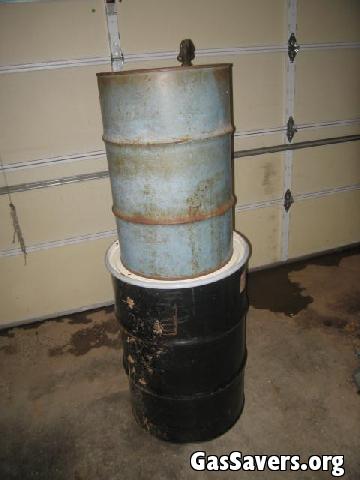
I carefully traced the small barrel's outline onto the large drum's removable lid and then cut out a hole with a jig saw.
I then used my wire MIG welder (.035 flux wire- I'm too cheap to buy the shielding gas) to carefully weld the 55 gallon lid around the top rim of the 30 gallon drum. I then applied a heavy bead of silicone caulk to the rim of the 55 gallon drum and set the lid (and small barrel) on it. Then I tightened the locking ring and gave it 14 hours for the caulk to dry.
I am a sloppy welder, so I wasn't surprised to see about 6-8 leaking spots in my weld when I filled the barrel with water while it was laying on its side (I cut a small hole in one side). I marked the leaks and went back and welded over them. I did this two more times and then I sprayed a heavy layer of black spray paint around the weld to help seal it. It worked!
Here's a close up of that important weld (painted black) and a fire going in the firebox.
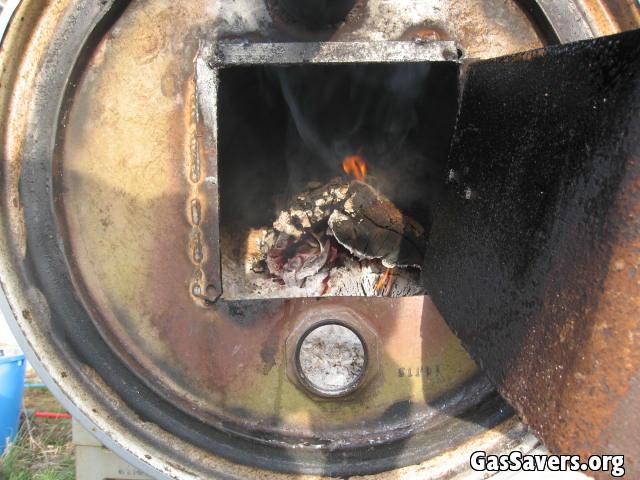
I did end up with a dripping leak in the silicone seal where the drum lid is pressed on to the drum (about 1 quart per hour).

I welded a bung in the bottom of the barrel where the cooler water enters it (blue pipe in the top pic) and one about 75% up the opposite side where the hot water is sucked out (red pipe in the bottom pic).
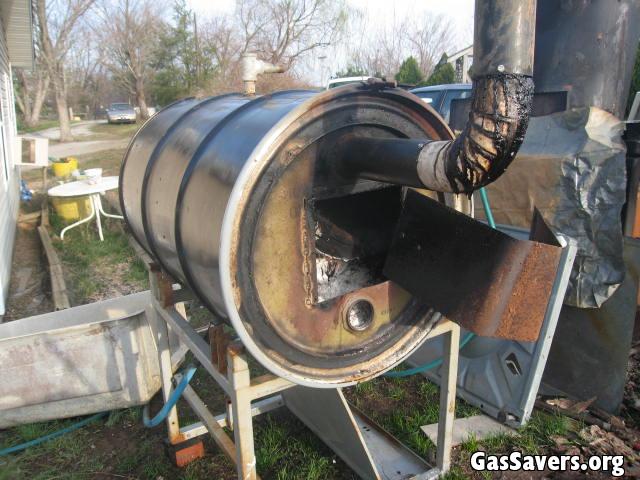

Yes, the door is pretty lousy/flimsy and I need to trim the excess off... The opening is about 8.5 inches square so I have to split a fair amount of wood so it will fit inside.
I typically cover the stove with a cheap car cover and half a large dog crate to try to reduce heat loss through the outside "skin".
The flue pipe is a horizontal thin walled 3 inch steel pipe that extends all the way back to within 6 inches of the back of the stove. This keeps the heat moving toward the back of the stove- in fact, since cool air enters around the cracks of the door and through the large bottom bung hole, the front of the stove never gets very hot (the paint is not even scorched yet).
I did need to extend the 3 inch flue pipe vertically up about 3-4 feet to provide enough draft for the stove to get enough air.
As you can see, there is a bit of creosote that seeps out of the flue joint. My wood is pretty dry, but combustion is incomplete especially when I first get it going in the morning and the large surface area of the exposed pipe does cool the smoke somewhat.

I have only been running the stove for 3 days, but it burns about 1/3rd of the wood as my original "leaning tower of pisa" water heater prototype did while heating the water to the same temp.
Shortcomings:
The main drawback of this heater is the small firebox. I screw in the drum's bung plug to reduce its air overnight, but it still is almost out in the morning when I get up. Making a better fitting door would help this issue/ would slow the fire down overnight so I would have more coals left in the morning.
I need to fill the stove every 3 hours to keep the water temp above 90 degrees. But it only burns an 8 inch diameter stick of wood to do this.
Since the water never gets very hot, I run the pump and fan all of the time. Perhaps I could have the pump and fan come on every 30 minutes and then go off for 30 minutes. This would save electricity and may give me hotter water temps when the fan does finally come on.
The firebox is just a regular thin steel drum so it will rust out- I'm sure one day I will go out and find the fire out and the firebox full of water= game over.
It does smoke some when I add wood (when the pics were taken) and when I start it up in the morning, but I live out in the country with distant neighbors so it is no big deal. I have thought of adding a blower to the lower bung to increase heat and decrease smoke.
My Costs:
Taco pump- about $90
3/4 PEX pipe and fittings and clamps - about $110 but I have lots left over
closed cell pipe insulation- $15
radiator- free (already had it laying around)
drums - 30 gallon = free, 55 gallon (used "juice concentrate" )= $12
welding supplies- at least $10 worth of wire
With a $230+ price tag, I don't think it has paid for itself yet, but most of the materials (pump, pipe and fittings) can be reused for other projects for years to come, so it will eventually begin saving us money.
Future plans
I think a 55 gallon drum firebox would be big enough to fill only twice a day- but then I would need a larger container to mount it in... I'm still thinking about that.
Many of the factory made outdoor furnaces have at least a 100 gallon water capacity and are well insulated on the outside. They typically use temp sensors and a draft control to keep the water at 170 degrees or so. Increasing my water capacity and insulating the outside would also likely be very helpful for my design.
Note: both of these water heaters were open to atmosphere pressure and have never heater the water up over 125 degrees- therefore there was never any risk of a steam explosion